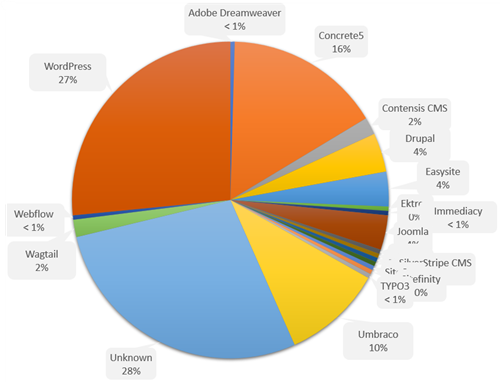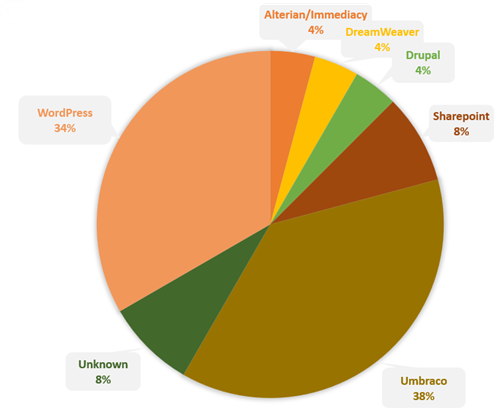NHS Content Management Systems
Published by Mark Buchner on 13 March 2022.
What are NHS organisations across the UK using to deliver web experiences to their users? We undertook a UK wide survey to understand the technology platforms in use. Only 3 different systems hit the 10% adoption line.
We’ve been having conversations recently about the software used by NHS organisations to manage their public facing websites. There are 100's of different software products available ranging from small to enterprise level, open source to weighty price tags. We got curious and so sent off an intrepid researcher to determine which organisations were using what. Our researcher looked at all 4 nations to see what was out there.
Unsurprisingly almost all organisations used some form of Content Management System (CMS), though not all. According to W3Techs 40% of websites globally do not use a known CMS - with the NHS this figure is lower at 28%. For those using CMSs the landscape wasn't as broad as we anticipated with only 20 different products identified across the whole of the UK (healthcare). Of the CMSs in use, 3 dominated: WordPress, Umbraco and Concrete5. Interestingly, all the top players are open source - makes sense - money and resource should be focused on delivering outputs rather than core infrastructure!
Within England we looked at 226 NHS Trusts and found a high level use of WordPress (27% 60 sites). Next came Concrete5 (16% 36 sites) and Umbraco (10% 23 sites). Many of the sites using Concrete5 or Umbraco were some of the larger or more prestigious Trusts, such as Christies or the Yorkshire Ambulance Service. We found over 60 sites where we could not identify the CMS platform used. This was either due to there being no CMS at all, or use of old technology, or use of a very niche/little known CMS platform.
Fig. 1: CMS distribution across NHS England
In Scotland we looked at all 14 regional Health Boards and included the national (special) boards for good measure. In Scotland Umbraco (38%) pips the post just slightly ahead of WordPress (34%) with the distribution being that all but a few of the large national bodies opted for Umbraco. All of the larger sites were using Umbraco, including: Public Health Scotland, NHS Education for Scotland, NHS24 (NHS inform), Scottish Ambulance Service, NHS National Services Scotland and NHS Greater Glasgow & Clyde.
Across the regional boards, the mix is WordPress (7 sites), Umbraco (3 sites) and SharePoint (2 sites). It should be noted that several of the boards are currently in the process of transitioning from existing platforms to new Content Management Systems.
Fig. 2: CMS distribution across NHS Scotland
Wales has 7 regional Health Boards (similar to Scotland), 3 Trusts and a number of national bodies including: Public Health Wales and Health Education and Improvement Wales (HIEW). All but one uses a WordPress system build and delivered by Digital Health and Care Wales.
Within Northern Ireland there are six health and social care trusts that sit within the Health and Social Care Board and all but one are using the same WordPress CMS system.
So across the whole of the UK there are only 3 different vendors who reach a 10% adoption line. Within England those are WordPress (27%), Concrete5 (16%) and Umbraco (10%). Across Scotland there are only 2 vendors, Umbraco (38%) and WordPress (34%).
We didn't dig into the details of product versions. Many of the vendors have different offerings, e.g. on-premise, cloud, headless, etc. Most sites employ cloud-based versions with some utilising new configurations such as headless, e.g. Umbraco's (headless) Heartcore.
The Tactuum team have used a number of Content Management Systems over the years including; Immediacy, SiteCore, Drupal and WordPress. We are, however, proud proponents of the Open Source Umbraco platform…we’re Gold Partners by choice.
WARNING: whilst correct technology choice is important, it is often less impactful than good content and good Service Design. Define the user needs to drive decision making, and...beware the technology evangelists!
For anyone interested, we can provide the raw data including organisation name, website URL and technology identified.


